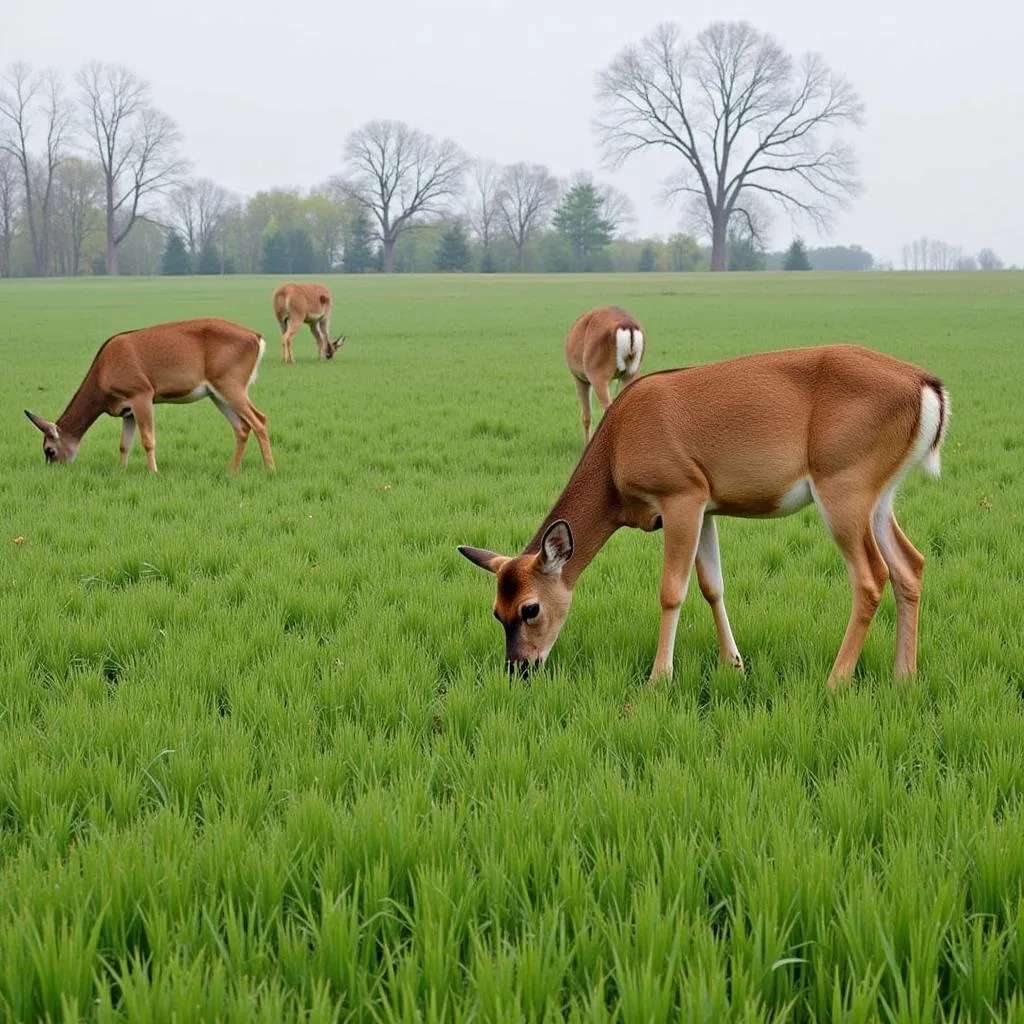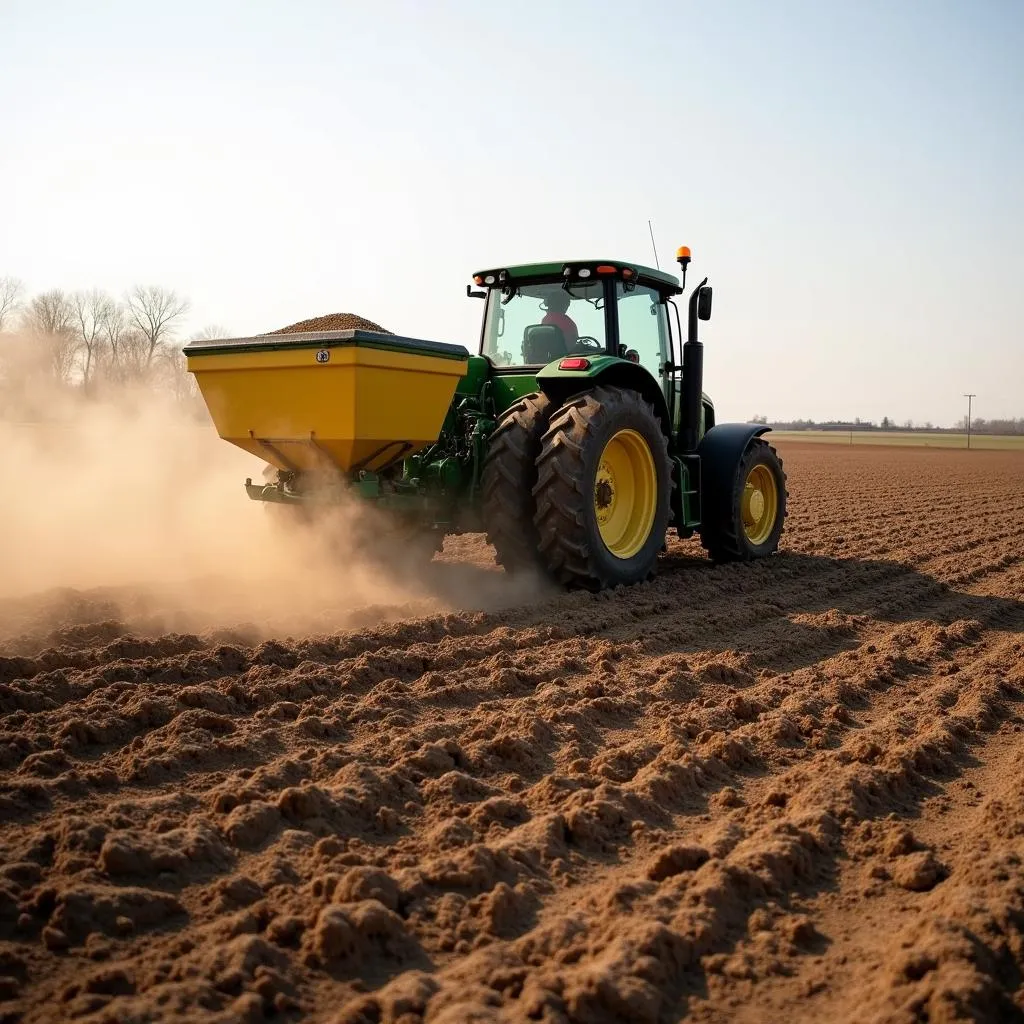Winter wheat is a popular choice for food plots, offering a number of benefits for both wildlife and hunters. This cool-season annual grain provides valuable forage during the fall and winter months when other food sources may be scarce. In this comprehensive guide, we will delve into everything you need to know about planting, growing, and maintaining a thriving winter wheat food plot that will attract deer and other wildlife to your property.
 Planting winter wheat seeds in a food plot
Planting winter wheat seeds in a food plot
Why Choose Winter Wheat for Your Food Plot?
Winter wheat is a highly palatable and nutritious food source for a variety of wildlife species, including white-tailed deer, turkeys, rabbits, and quail. It’s rich in carbohydrates, which are essential for providing energy during the colder months when animals need it most. Here are some compelling reasons to consider winter wheat:
- High Nutritional Value: Winter wheat boasts a good balance of carbohydrates, protein, and fiber, contributing to the overall health and well-being of the animals that consume it.
- Cold Tolerance: As a cool-season crop, winter wheat thrives in colder temperatures and can withstand frost and even light snow cover, making it an ideal choice for fall and winter food plots.
- Attracts a Variety of Wildlife: The palatable nature of winter wheat makes it attractive to a wide array of wildlife species, enhancing the biodiversity of your property.
- Erosion Control: The extensive root system of winter wheat helps to prevent soil erosion, making it an environmentally friendly choice for food plots.
- Cost-Effective: Winter wheat seeds are generally affordable compared to some other food plot options.
 White-tailed deer grazing on lush winter wheat in a food plot
White-tailed deer grazing on lush winter wheat in a food plot
When to Plant Winter Wheat for Food Plots
The optimal time to plant Winter Wheat For Food Plots varies depending on your geographic location and climate. In general, it’s best to aim for a planting window that allows the wheat to establish a strong root system and some early growth before the first frost arrives.
- Northern Regions: Early to mid-August is typically the ideal time for planting winter wheat in northern regions.
- Southern Regions: In southern areas with milder winters, planting can be delayed until September or even early October.
Selecting the Right Variety of Winter Wheat
Not all winter wheat varieties are created equal when it comes to food plots. Consider these factors:
- Grazing Tolerance: Opt for varieties specifically bred for grazing tolerance, as they can withstand repeated browsing by deer and other animals.
- Disease Resistance: Choose disease-resistant varieties to minimize the risk of fungal or bacterial infections that can impact the health of your food plot.
- Maturity Date: Consider the expected maturity date of the variety and select one that aligns with your local hunting season.
Preparing Your Food Plot for Winter Wheat
Proper site preparation is essential for ensuring the success of your winter wheat food plot.
- Soil Testing: Before planting, conduct a soil test to determine the pH level and nutrient content of your soil. This information will help you make necessary amendments.
- Weed Control: Eliminate existing weeds and unwanted vegetation through tilling, herbicide application, or a combination of both methods.
- Soil Amendment: Based on your soil test results, incorporate any necessary lime or fertilizer to adjust pH and provide essential nutrients.
- Seedbed Preparation: Create a smooth, firm seedbed by lightly tilling or disking the soil.
 Spreading fertilizer on a prepared winter wheat food plot
Spreading fertilizer on a prepared winter wheat food plot
Planting Your Winter Wheat
Follow these steps for planting your winter wheat seeds:
- Seeding Rate: The recommended seeding rate for winter wheat in food plots is typically higher than for grain production. Aim for around 100 to 120 pounds of seed per acre.
- Planting Depth: Plant winter wheat seeds approximately 1 to 1.5 inches deep into the soil.
- Seeding Method: You can use a broadcast spreader or a no-till drill to sow the seeds.
- Covering the Seeds: Lightly rake or drag the soil to cover the seeds after planting.
Winter Wheat Food Plot Maintenance
- Fertilization: A well-timed fertilizer application in the early spring can boost the growth and yield of your winter wheat.
- Weed Control: Monitor your food plot for weeds and address them promptly to prevent competition with your winter wheat.
- Rest and Rotation: Avoid overgrazing by providing adequate rest periods for your food plot. Consider rotating crops to improve soil health and reduce pest pressure.
Expert Insights
“When choosing a winter wheat variety for food plots, don’t overlook the importance of local knowledge,” advises Sarah Miller, a wildlife biologist with over 15 years of experience. “Consult with your local agricultural extension agent or experienced food plotters in your area to identify varieties that have a proven track record of success in your specific region.”
Conclusion
Planting a winter wheat food plot is a rewarding endeavor that can significantly enhance the habitat on your property and attract a variety of wildlife. By following the guidelines outlined in this comprehensive guide, you’ll be well on your way to establishing a thriving winter wheat food plot that will provide valuable forage and attract deer and other animals for years to come.
FAQs
1. Can I plant winter wheat in the spring?
While winter wheat is typically planted in the fall, it can be planted in the spring in some regions as a spring wheat crop. However, fall planting is generally recommended for optimal growth and yield.
2. How tall will my winter wheat grow?
The height of winter wheat can vary depending on the variety and growing conditions but typically ranges from 2 to 4 feet tall.
3. How long does it take for winter wheat to mature?
Winter wheat generally takes around 280 to 300 days to reach maturity, depending on the variety and environmental factors.
4. Can I plant other food plot species with my winter wheat?
Yes, winter wheat can be successfully interseeded with other compatible food plot species, such as clover or brassicas, to provide a more diverse forage option.
5. What are some common pests of winter wheat?
Common pests of winter wheat include aphids, armyworms, and Hessian flies. Implement integrated pest management strategies to monitor for and control these pests.
Need expert advice on selecting the best winter wheat varieties for your food plot? Don’t hesitate to contact us. Our dedicated team at Mina Cones Food is available 24/7 to assist you. Reach us by phone at 02437655121, email us at [email protected], or visit us at our location in Hanoi: 3PGH+8R9, ĐT70A, thôn Trung, Bắc Từ Liêm, Hà Nội, Việt Nam.